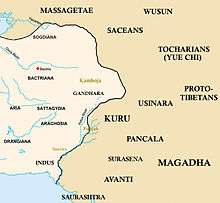Haryanka dynasty
| Haryanka dynasty | |||||||||||||
|---|---|---|---|---|---|---|---|---|---|---|---|---|---|
| Middle of 6th century BCE–413 BCE | |||||||||||||
.png) The approximate extent of the Haryanka dynasty between the 6th and 5th century BCE. | |||||||||||||
| Capital |
Rajagriha later Pataliputra | ||||||||||||
| Common languages |
Sanskrit Magadhi Prakrit Other Prakrits | ||||||||||||
| Government | Monarchy | ||||||||||||
• 544-492 BCE | Bimbisara | ||||||||||||
• 492-460 BCE | Ajatashatru | ||||||||||||
• 460-440 BCE | Udayin | ||||||||||||
• | Anuruddha | ||||||||||||
• | Munda | ||||||||||||
• 437-413 BCE | Nāgadāsaka | ||||||||||||
| History | |||||||||||||
• Established | Middle of 6th century BCE | ||||||||||||
• Disestablished | 413 BCE | ||||||||||||
| |||||||||||||
| Today part of |
| ||||||||||||
The Haryanka dynasty was the second ruling dynasty of Magadha, an ancient kingdom in India, which succeeded the mythological Barhadratha dynasty. The reign of this dynasty probably began in the middle of 6th century BCE. Initially, the capital was Rajagriha. Later, it was shifted to Pataliputra, near the present day Patna in India. Brihadaratha founded the dynasty around 566 BCE, although Bimbisara, his grandson, significantly expanded the dynasty's boundaries during his rule from 544 BCE to 492 BCE. Thus Bimbisara is considered as the main founder of the dynasty.
According to the Buddhist text, the Mahavamsa, Bimbisara was anointed king by his father, Bhattiya, at the age of fifteen.[1]
Bimbisara

According to George Turnour and N.L. Dey, the name of the father of Bimbisara was Bhatiya or Bhattiya, but the Puranas refer him as Hemajit, Kshemajit, Kshetroja or Ksetrauja and the Tibetan texts mention him as Mahapadma.[2]
The Haryanka king Bimbisara was responsible for expanding the boundaries of his kingdom through matrimonial alliances and conquest. The land of Kosala fell to Magadha in this way. He is referred to as King Shrenik in Jain scriptures.
Estimates place the territory ruled by this early dynasty at 300 leagues in diameter, and encompassing 80,000 small settlements.
Ajatashatru
In some sources, Bimbisara was imprisoned and killed by his son and successor, Ajatashatru, under whose rule the dynasty reached its largest extent. Ajatashatru was contemporary with Mahavira (599–527 BCE) and Gautama Buddha (563–483 BCE). Ajatashatru fought a war against Vajji, ruled by the Lichhavis, and conquered the republic of Vaisali. Ajatashatru followed policies of conquest and expansion. He defeated his neighbors including the king of Kosala; his brothers, when at odds with him, went to Kashi, which had been given to Bimbisara as dowry. This led to a war between Magadha and Kosala. Ajatashatru occupied Kashi and captured the smaller kingdoms. Magadha under Ajatashatru became the most powerful kingdom in North India.
Udayin
The Mahavamsa states that Udayabhadra eventually succeeded his father, Ajātasattu, moving the capital to Pataliputra, which, under the later Mauryan dynasty, would become the largest city in the world. He is believed to have ruled for sixteen years from 460 BCE to 444 BCE.
Later rulers
The kingdom had a particularly bloody succession. Anuruddha eventually succeeded Udaybhadra through assassination, and his son Munda succeeded him in the same fashion, as did his son Nagadasaka.
Due in part to this bloody dynastic feuding, it is thought that a civil revolt led to the emergence of the Shishunaga dynasty.
See also
Notes
- ↑ Raychaudhuri 1972, pp. 97
- ↑ Raychaudhuri 1972, p. 105ff
References
- Raychaudhuri, H.C. (1972), Political History of Ancient India, Calcutta: University of Calcutta
- Bhargava, P.L., The origins of the Nanda (PDF)
| Preceded by Pradyota dynasty |
Haryanka dynasty middle of 6th century –425 BCE |
Succeeded by Shishunaga dynasty |